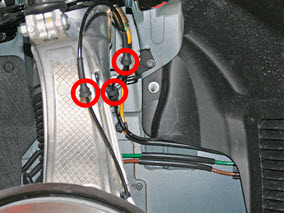Tesla Model S: Driveshaft Assembly - Front - RH (Remove and Replace)
Warning: If the vehicle has air suspension, activate "Jack" mode on the touchscreen before raising and supporting the vehicle.
Removal
- Remove the RH front wheel (refer to procedure).
- While having an assistant press the brake pedal, loosen the RH front axle nut, but do not remove it yet.
- Position the vehicle in preparation for raising it, but do not raise it at this time.
- Remove the 12V battery bracket beam (refer to procedure).
- Release the straps that secure the lower RH section of the acoustic cover around the front drive unit. Remove only the lower RH section of the cover to access the drain plug.
- Set the fluid transfer pan into position beneath the drain plug.
Ensure that the pan is level, then route the drain hose between the
subframe and aeroshield so that it will drain into an oil drain pan.
.png)
- Remove the drain plug (torque 28 Nm) and drain the fluid.
- Raise and support the vehicle.
- Remove the RH front axle nut (torque 205 Nm).
- Working in the RH wheelwell, release the rubber grommets that
secure the front wheel speed sensor harness to the body (x2) and the
knuckle (x1).

- Remove the bolt and nut that secure the knuckle to the upper
control arm ball joint (torque 60 Nm).
.png)
- Disconnect the upper control arm from the knuckle.
.png)
- Restrain the tie rod ball joint pin, then remove the nut that
secures the tie rod end to the knuckle (torque 103 Nm).
Caution: To prevent ball joint damage, always hold the ball joint pin with a wrench while loosening or tightening the lock nut.
.png)
- Remove and discard the bolt that secures the sway bar to the
sway bar end link (torque 70 Nm).
.png)
- Release the axle from the hub.
- Lower the vehicle to access the underhood area.
- Remove the RH driveshaft from the jackshaft.
Tip: Use a deadblow hammer to separate the driveshaft.
.png)
Note: Place suitable absorbent material around the affected area to absorb any fluid spillage.
- Working from the RH wheelwell, remove the driveshaft from the vehicle.
- Remove the nut and bolt that secure the spring and damper
assembly to the lower arm (torque 140 Nm).
Caution: Take care not to damage component(s).
Caution: Replace all nylon-insert locknuts.
Note: The following image shows a rear wheel drive (RWD) assembly. The assembly in a dual motor (DM) vehicle looks different.
.png)
- Working from the RH wheelwell, remove the axle from the vehicle.
Installation procedure is the reverse of removal.

